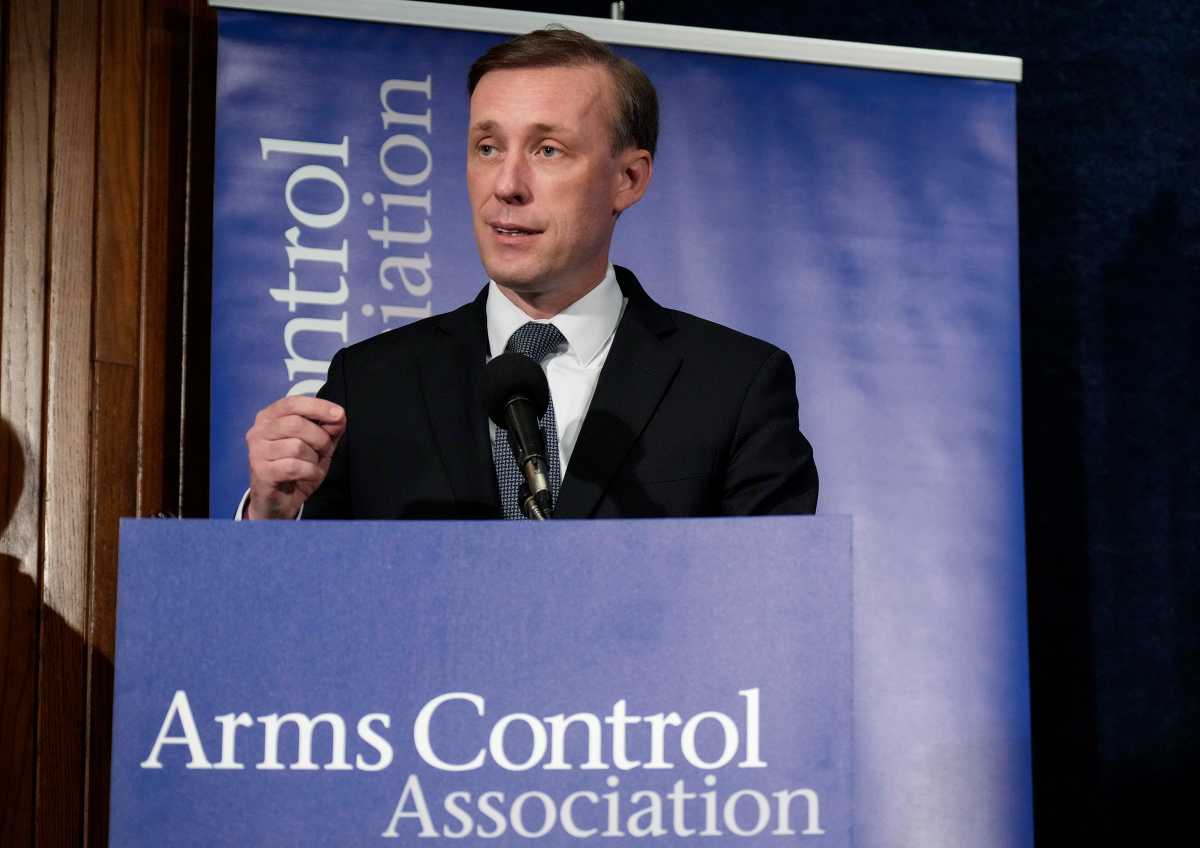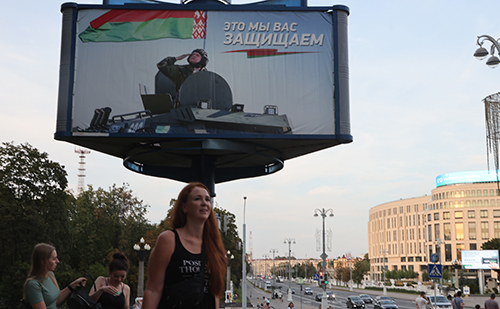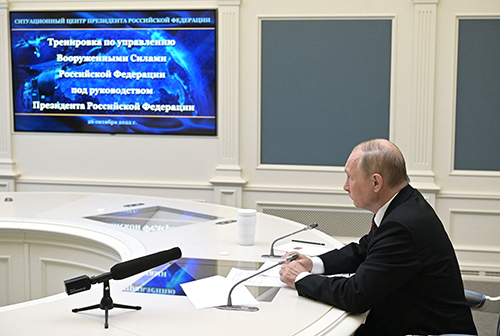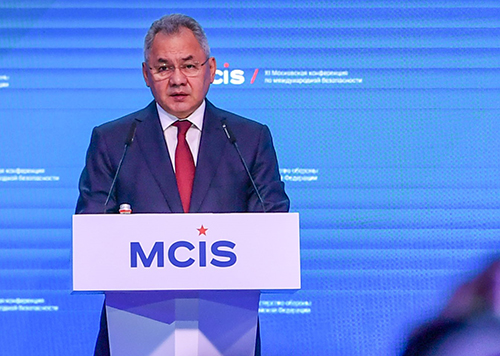The United States has yet to send a formal written arms control proposal to Russia, three months after U.S. National Security Advisor Jake Sullivan first outlined the Biden administration’s strategy and suggested arms control talks in a June address.
 “We discussed [Sullivan’s speech] verbally several times at various levels,” Russian Deputy Foreign Minister Sergey Ryabkov acknowledged in a Sept. 6 interview with Kommersant. But Moscow has yet to receive the proposal “on paper,” he added, ascribing it to the “extremely sporadic and unsystematic” approach to arms control by the Biden administration.
“We discussed [Sullivan’s speech] verbally several times at various levels,” Russian Deputy Foreign Minister Sergey Ryabkov acknowledged in a Sept. 6 interview with Kommersant. But Moscow has yet to receive the proposal “on paper,” he added, ascribing it to the “extremely sporadic and unsystematic” approach to arms control by the Biden administration.
In July, Ryabkov stated that, based on communications with Washington at that time, “we are not ready to and will not conduct this dialogue based on what the Americans are now proposing, as they ignore several key points.” Moscow has repeatedly asserted that nuclear arms control cannot be “compartmentalized” apart from other issues that affect strategic stability, such as the war in Ukraine, among other things.
A National Security Council spokesperson said July 26 that the United States “remains open to discussing nuclear risks and the future of arms control with Russia,” but “the Russian side appears not to share this willingness.” The spokesperson noted the administration “privately” conveyed the proposal to Moscow but declined to elaborate at the time.
Thomas Countryman, former acting undersecretary for arms control and international security, encouraged the Biden administration to send a proposal expeditiously. “Pushing even simple ideas through the U.S. bureaucracy is always a daunting task,” he wrote in Just Security Sept. 12. “Still, the failure to take the next step is inconsistent with the urgency Sullivan’s speech correctly conveyed.”
Russian Foreign Minister Sergey Lavrov stated Aug. 19 that Russia’s nuclear weapon arsenal remains necessary to ensure its national security, describing this claim as “well-grounded” given “the developments in and around Ukraine.”
“A great danger in the context of the Ukrainian conflict is linked with the fact that the United States and NATO countries, while gearing up for confrontation, run the risk of becoming involved in a direct armed clash between nuclear powers,” continued Lavrov. To prevent such an outcome, “we must remind everyone about the existence of enormous military and political risks and send sobering signals to our opponents.”
If Washington and Moscow do resume an arms control dialogue, the talks would likely focus on potential arrangements to follow the expiration of the 2010 New Strategic Arms Reduction Treaty (New START) in February 2026.
On July 26, the U.S. State Department released an annual assessment which determined that New START continues to enhance U.S. national security despite the ongoing dispute with Russia that has halted treaty activities, such as on-site inspections of nuclear weapons-related facilities and daily notifications on the status and the location of treaty-accountable items. —SHANNON BUGOS, senior policy analyst
Lukashenko Wields Threat of Russian Tactical Nuclear Weapon Use
Amid the purported transfer of Russian tactical nuclear weapons to Belarus, Belarusian President Alexander Lukashenko claimed Aug. 17 that “we will not tarry [or] wait” to “use them immediately once aggression is launched against us.”
 “We didn’t bring nuclear weapons here in order to scare someone,” he added.
“We didn’t bring nuclear weapons here in order to scare someone,” he added.
Previously, Lukashenko emphasized his certainty that “we will never have to use [Russian tactical nuclear weapons] while they are here.”
Regardless, Russia has maintained that Russian President Vladimir Putin will retain control over the use of the weapons, despite Lukashenko’s July 6 assertion that “control is carried out perfectly, jointly by Belarusians and Russians.”
Furthermore, Western governments and nuclear experts continue to debate whether Russia has indeed transferred tactical nuclear weapons to Belarus.
U.S. Defense Intelligence Agency senior officials told CNN July 21 that they have “no reason to doubt” the deployment. They acknowledged that the weapons, which would be placed in storage rather than forward deployed, are tricky for the intelligence community to track.
UK Defense Secretary Ben Wallace also told CNN that the United Kingdom has “seen signs of this [transfer] progressing,” adding that Putin “doesn’t always lie.”
Polish President Andrzej Duda commented similarly Aug. 22, saying that “this process is taking place, we are seeing that.”
“It is changing the architecture of security in our immediate neighborhood, but also of the eastern flank of NATO,” he added.
Yet, other Western officials speaking anonymously told CNN July 7 that Belarus does not appear to have the proper infrastructure for housing the weapons, an assessment shared by Hans Kristensen and Matt Korda of the Federation of American Scientists.
“Our observations and analyses show no clear observable indicators of construction of the facilities we expect would be needed to support transport and deployment of Russian nuclear weapons into Belarus,” they wrote in a June 30 blog post. “We are underwhelmed by the lack of visual evidence.”
Russia announced in June that the transfer of tactical nuclear weapons to Belarus had begun, with a completion date in early July. Moscow has refused to disclose how many tactical nuclear weapons it has planned to send to Belarus.
No Signs of Potential Russian Nuclear Use, U.S. Says
National Security Council spokesperson John Kirby stated in June that, despite “the blustery rhetoric” from Russia, “we’ve seen no indication that there’s any intent to use nuclear weapons inside Ukraine.” Kirby also assured that Washington has “seen nothing that would compel us to change our own strategic deterrent posture.”
 The Biden administration, as well as U.S. allies and partners, has made both these assurances repeatedly over the course of Russia’s war in Ukraine.
The Biden administration, as well as U.S. allies and partners, has made both these assurances repeatedly over the course of Russia’s war in Ukraine.
“We haven’t seen any changes in their nuclear forces that trigger us to change our forces and the way those are arranged,” said NATO Secretary-General Jens Stoltenberg Aug. 17.
U.S. President Joe Biden also warned Russian President Vladimir Putin against using nuclear weapons in the war on Ukraine. “Don’t go there,” Biden said July 13. “I don’t think there’s any real prospect—you never know, but—of Putin using nuclear weapons,” he continued, noting that other countries such as China have warned Putin as well.
According to a July 5 report by the Financial Times, Chinese President Xi Jinping advised Putin during his March visit to Russia against nuclear weapons use. The Kremlin denied the report.
In late July, U.S. Senator Lindsey Graham (R-S.C.) further cautioned Moscow that a nuclear weapons strike in Ukraine “would be an attack on NATO itself, given Ukraine’s proximity to NATO territory.”
A one-day mutiny by the Wagner Group, a Russian paramilitary group heavily involved in the invasion of Ukraine, sparked concerns in the summer over the custody and security of Russian nuclear weapons, as the group moved within 100 miles during its march to Moscow of two sites that have stored nuclear weapons.
The head of Ukrainian intelligence, Kyrylo Budanov, told Reuters in a July 11 interview that Wagner forces reached the Voronezh-45 facility and planned to acquire small Soviet-era nuclear weapons.
But the U.S. National Security Council said that it could not corroborate the report. Reuters also could not independently verify the claim, while Russia denied it entirely.
Nuclear experts have been skeptical that Wagner aimed to obtain Russian nuclear weapons, let alone operationalize them.
U.S. Nuclear Mission May Be Returning to UK
Fifteen years after withdrawing, U.S. nuclear weapons may be headed back to the United Kingdom, according to an analysis by the Federation of American Scientists Aug. 28.
 The analysis homed in on Air Force budget documents for fiscal year 2024, which revealed plans for the construction of a dormitory at Royal Air Force Lakenheath due, at least in part, to “the arrival of the potential Surety mission.” The United States often employs the term “surety” when referring to the safety and security of U.S. nuclear weapons.
The analysis homed in on Air Force budget documents for fiscal year 2024, which revealed plans for the construction of a dormitory at Royal Air Force Lakenheath due, at least in part, to “the arrival of the potential Surety mission.” The United States often employs the term “surety” when referring to the safety and security of U.S. nuclear weapons.
Construction will aim to begin in June 2024 and finish in February 2026.
These upgrades to Lakenheath coincide with the arrival of the new nuclear B61-12 gravity bombs to Europe under the NATO nuclear sharing mission and the U.S. Air Force squadron located at the UK base becoming equipped with the nuclear-capable F-35A Lightning II jets.
Russian Foreign Ministry spokesperson Maria Zakharova warned the United States against returning its nuclear mission to the United Kingdom.
“If this step is ever taken, we will view it as escalation, as a step that would take things in a direction that is quite opposite to addressing the pressing issue of pulling all nuclear weapons out of European countries,” she told reporters on Sept. 5.
For the full analysis, see “Increasing Evidence That The US Air Force’s Nuclear Mission May Be Returning To UK Soil,” by Matt Korda and Hans Kristensen, Federation of American Scientists, Aug. 28, 2023
Speculation of Russian Return to Nuclear Testing Surges
Russian Defense Minister Sergey Shoigu visited Novaya Zemlya, a Soviet-era nuclear test site located in the far north, in mid-August, increasing speculation that Moscow is considering a resumption of nuclear weapons testing.
 Shoigu was accompanied by Alexei Likhachev, the general director of Rosatom, a Russian state nuclear company, in an inspection of the former nuclear test site where “tests of advanced samples of weapons and military equipment” now take place, according to a Russian Defense Ministry statement. The last nuclear test at Novaya Zemlya took place in 1990.
Shoigu was accompanied by Alexei Likhachev, the general director of Rosatom, a Russian state nuclear company, in an inspection of the former nuclear test site where “tests of advanced samples of weapons and military equipment” now take place, according to a Russian Defense Ministry statement. The last nuclear test at Novaya Zemlya took place in 1990.
The visit garnered particular attention given recent statements by Putin about a potential return to nuclear testing and recent news reports revealing debates among Russian officials about whether to withdraw Russia’s ratification of the 1996 Comprehensive Test Ban Treaty (CTBT). The CTBT prohibits all nuclear weapon test explosions, but the treaty has not officially entered into force.
“The Defense Ministry and Rosatom must make everything ready for Russia to conduct nuclear tests,” Putin said in February during a speech announcing the suspension of New START. “We will not be the first to proceed with these tests, but if the United States goes ahead with them, we will as well.”
The Kommersant reported Aug. 3 that, over the past few months, Russian officials have discussed the potential for Moscow to withdraw from the CTBT in order to achieve “complete parity” with the United States, which has not ratified the treaty.
Two days later, Moscow called on the United States “to review its beliefs and misguided policies with respect to the CTBT, accept its responsibility, make a step in the right direction…and ratify the [CTBT], resisting the temptation to resume nuclear tests under any pretext.”
On the International Day Against Nuclear Testing, Bonnie Jenkins, U.S. undersecretary for arms control and international security, emphasized the Biden administration’s concern about “the disturbing nuclear rhetoric from the Russian Federation over the past year and a half – in particular, President Putin’s statement in February about Russia’s willingness to resume nuclear explosive testing.”
Jenkins also reiterated that “the United States has maintained a zero-yield moratorium on nuclear explosive testing and calls on all states possessing nuclear weapons to declare or maintain such a moratorium” in the Aug. 29 statement.
Divisions Remain Among NPT States
The first preparatory committee meeting for the 11th Review Conference for the nuclear Nonproliferation Treaty (NPT) emphasized the stark divisions among states-parties, culminating in a failure to agree upon a final document.
Longstanding frustrations between nuclear-weapon and non-nuclear-weapon states over nuclear disarmament emerged as non-nuclear-weapon states insist that countries possessing nuclear weapons have not done enough to uphold their treaty obligation “to pursue good faith measures to the cessation of an arms race at an early date and to disarmament.”
Attention particularly focused on the need for the world’s two largest nuclear weapons possessors, the United States and Russia, to ensure full New START implementation and to commit to deeper reductions in their respective nuclear arsenals.
The first committee meeting took place July 31-Aug. 11 in Vienna, and the second will follow in July 2024. The review conference is scheduled for 2026.
Also in August, Russia officially became the chair of the P5 Process, which includes the five nuclear-weapon states recognized by the NPT: China, France, Russia, the United Kingdom, and the United States.
The P5 Process last met in June in Cairo at the “experts” level, according to the United States, which served as chair at the time.
In a Sept. 6 interview with Kommersant, Russian Deputy Foreign Minister Sergey Ryabkov described Moscow’s intention to encourage “less talk, more action” within the P5 Process.
“We will work within the framework of the agenda, maintaining a certain continuity,” he said, but cautioned that “we would not want this format to be limited almost exclusively to the topic of reducing nuclear risks.”
For a full report on the first preparatory committee meeting for the NPT review conference, see: “NPT Meeting Underscores Chronic Divisions,” by Gabriela Iveliz Rosa Hernández, Jupiter Kaishu Huang, and Daryl Kimball, Arms Control Today, September 2023
New Russian Nuclear Weapon Delivery Systems Progress
Russia’s new nuclear-armed heavy intercontinental ballistic missile (ICBM), the Sarmat, has officially entered service in September, according to Russia’s space agency.
“The Sarmat strategic system has assumed combat alert posture,” said Yuri Borisov, director general of Roscosmos, on Sept. 1.
Russian President Vladimir Putin first announced the Sarmat in March 2018. He described the new ICBM as having multiple warheads, a short boost phase, and an advanced ability to evade missile defenses.
Two months after Russia’s invasion of Ukraine, Putin said that the Sarmat ICBM would “reliably ensure the security of Russia from external threats and make those who, in the heat of aggressive rhetoric, try to threaten our country, think twice.”
Since the start of 2023, Putin has repeatedly stated that the Sarmat would be deployed within the calendar year.
In addition, Russia has conducted successful tests on parts of a new nuclear-powered, nuclear-armed uncrewed underwater torpedo, named the Poseidon, according to multiple news reports in June.
Russian sources told reporters that the first “sea tests” would occur over the summer.
TASS, a Russian state-owned news agency, reported in January that Russia had produced the first of set Poseidon torpedoes, with the Belgorod submarines expected to receive them soon.
News & Analyses
- “US-Russia Nuclear Arms Control Talks 'Without Preconditions’: Somebody Has to Make the First Move,” by Thomas Countryman, Just Security, Sept. 12, 2023
- “It’s hard times now — and ahead — for US-Russian nuclear arms control,” by Frank Klotz and William Courtney, Defense News, Aug. 25, 2023
- “While Advocating Nuclear Transparency Abroad, Biden Administration Limits It At Home,” by Hans Kristensen and Matt Korda, Federation of American Scientists, July 31, 2023
- “‘Oppenheimer’, the bomb, and arms control, then and now,” by Daryl Kimball, Bulletin of the Atomic Scientists, July 29, 2023
- “The West Cannot Cure Russia’s Nuclear Fever,” by Hanna Notte, War on the Rocks, July 18, 2023
- “A New Approach to Arms Control,” by Ulrich Kühn and Heather Williams, Foreign Affairs, June 14, 2023
- “How the United States and NATO can deal with Russian nuclear coercion in Ukraine,” by Alexander Vershbow, Bulletin of the Atomic Scientists
